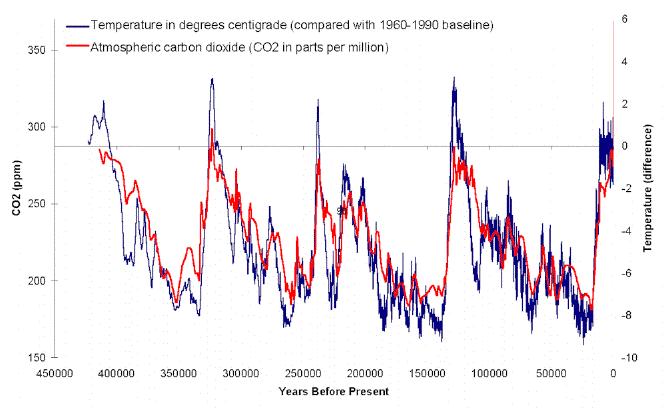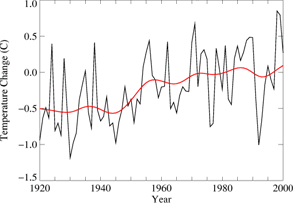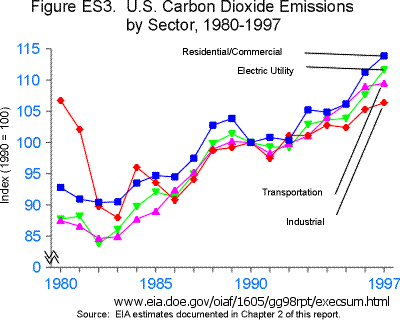Under Construction 
Problem
The presence of the greenhouse gases carbon dioxide (CO2), methane (CH4) and nitrous oxide (N2O) in the atmosphere causes heat from the earth which would normally be radiated out to space to be retained in the atmosphere.
Most of this increase is from Anthropogenic (derived from human activities) sources. Electrical power generation, Industrial Processes, Transportation and Agriculture account for 65% of the gasses.
Science
Case for Warming
- We have had 27 consecutive years with the global average temperature greater than the 120 year historical average.
- The polar ice caps are melting.
- The four highest average world temperature years all occured within the last 6 years:
- 1998 58.17°
- 2002
- 2003
- 2001
- In 2003 Glaciers in Argentina and Chile are melting at double the rate of 1975
- Ice shelves the size of Rhode Island have broken off of Antartica since 1995.
- The Intergovernmental Panel on Climate Change's (IPCC) Fourth Assessment Report in 2007 states that the probability of human influence on Climate Change is over 90%.
- Temperatures are rising 3 times as fast ofer the last three decades as it did over the entire 20th century.
Skeptics
There are still skeptics, who point to normal waraming cycles (on the order of 100,000 years) and short term (decade) cycles in the north atlantic as the reason for the current changes.
There are also warming effects from slight changes in the earth's orbit and solar cycles. However, the number of skeptics is declining.
See Global Warming Skeptics.
Some of their arguments:
Warming is part of a natural cycle:
There are hisorical cycles of warming and cooling (e.g. an ice age every 100,000 years):
However, the current rate of change (1°F in the northern hemisphere in the last 50 years) is much greater than any in the last 500 (some say 1,300) years.
There are several theories for these natural cycles:
One the earth's orbit is not round and we get closer to the sun every so often.
And the suns output increases every 11 years or so. However the change in solar radiation has only benn about 0.1% over the last 50 years which would not account for magnitude of the warming.
Also, the lower atmosphere (troposphere) is warming while the upper atmosphere (stratosphere) is cooler. If the sun was causing the warming both would be getting warmer.
Intresting Plots
400,000 yrs:
This figure shows the temperature record from the Vostok ice core (dark blue), together with CO2 (red) from the Vostok ice core, the Law Dome ice core, and from the Mauna Loa monitoring station in Hawaii. The near vertical line on the right represents the change in CO2 associated with the industrial revolution.
 Source: (www.brighton73.freeserve.co.uk/gw/paleo/)
Source: (www.brighton73.freeserve.co.uk/gw/paleo/)
Similar chart: www.worldviewofglobalwarming.org/pages/references2.html
Al Gore shows a similar chart to the above in his 2006 movie "An Inconvenient Truth".
I don't know why they use this chart because it seems to indicate there are natural cycles way before our current increase in greenhouse gas emissions and CO2 increases seem to lag the warming.
One explanation is the time resolution of these two records is too low to provide a accurate comparison.
Another explanation at RealClimate.org says "The CO2 does not initiate the warmings, but acts as an amplifier once they are underway. CO2 might be stored in the deep ocean during ice ages, and then get released through natural ocean currents when the climate warms."
1,000 yrs:

Source: http://www.manicore.com/anglais/documentation_a/greenhouse/rise_start.html
80 yrs:

Source: www.climatechange.govt.nz
Sources of CO2 and greenhouse gasses
  
Source: Greenhouse Gases, Climate Change, and Energy from the Energy Information Administration (EIA) at the Dept. of Energy (DOE)
Politics
Solutions
Green Living has information about hybrid cars, solar panels for your home, Fluorescent lighting and more.
Sierra Club Cool Home Presentation and checklist
Slow Population Growth:
The world population has grown from 2.5 Billion in 1950 to 6.1 Billion in 2000 and is expected to reach 9.2 Billion by 2050, 50% growth. Europe and Japan will have negative growth (due primairly to lower fertility rates) over the next 50 years. China will have a growth rate of 11%, the U.S. will grow by 41%, India by 58%, Nigeria at 131% and Pakistan at 102%.
See Top 10 countries for growth.
Recent data shows that fertility (average number of children per woman is dropping faster than expected in developing countries. This has been attributed to better education and women having more choice rather than government policy.
See: World Population
In a Feb. 16, 2006 article "Greenland's glaciers losing ice at faster rate" at MSNBC is said:
"The evolution of the ice sheet, in the context of climate warming, is more rapid than has been predicted by models," one of the researchers, Eric Rignot of NASA's Jet Propulsion Laboratory, told MSNBC.com. Satellite observations indicate that Greenland's glaciers have been dumping ice into the Atlantic Ocean at a rate that's doubled over the past five years.
A Friday October 17, 2003 article in The Guardian
"Warming doubles glacier melt" said:
Glaciers in Argentina and Chile are melting at double the rate of 1975 because of global warming scientists said yesterday, after calculating that the ice lost between 1995 and 2000 was equivalent to a rise in sea level of about 0.105mm a year.
Scientists combined space observation and survey data of the 63 largest Patagonian ice fields. Comparing ice loss rates from 1968-1975 and 1975-2000 they found it had more than doubled.
The researchers, led by Eric Rignot, from the Jet Propulsion Laboratory in Pasadena, California, wrote in the journal Science that the Patagonian glaciers accounted for 9% of the glacial contribution to sea level rises, while those in Alaska were behind sea level rises of 30%. Yet in Patagonian the area covered by glaciers was five times smaller than that in Alaska.
The greater "vulnerability" of Patagonia to climate change was due to the glaciers' higher turnover rates and a "dominance of calving glaciers".
Solutions: (pros and cons)
Sequestration - burying the CO2
Terms:
* Anthropogenic - derived from human activities.
* Carbon sequestration - the process through which plant life removes CO2 from the atmosphere and stores it in biomass.
* Geologic sequestration - a chain of activities that result in collection and transport of concentrated CO2 gas from large emission sources, such as power plants, and subsequent injection into deep underground reservoirs.
Related Issues:
Global warming was blamed on the increase in hurricanes in 2005, but 2006 and 2007 have had a below average number of hurricane.
links:
Green Living (Cool Cities, Green Buildings)
Energy Statistics
National Climatic Data Center - NCDC Climate Monitoring at NOAA
Greenhouse Gases, Climate Change, and Energy at the Dept. of Energy (DOE)
Sources of Carbon Dioxide, 1997 from the EPA
Emissions of Greenhouse Gases in the United States 2005
United Nations Framework Convention on Climate Change (UNFCCC)
Greenhouse gas at Wikipedia
Climatology; Ice Ages at U. Oregon
Global Warming and Clean Energy at the National Sierra Club
TEN POPULAR MYTHS About Global Climate Change at the Sierra Club of Canada
WorldViewOfGlobalWarming.org - The World View of Global Warming project is documenting this change through science photography from the Arctic to Antarctica, from glaciers to the oceans, across all climate zones.
Global Warming page at Raritan Valley Sierra Club
Skeptics at the above page.
Global Warming Center at AccuWeather.com
Return to Environment
last updated 23 Apr 2007
|

 Source: (www.brighton73.freeserve.co.uk/gw/paleo/)
Source: (www.brighton73.freeserve.co.uk/gw/paleo/)

